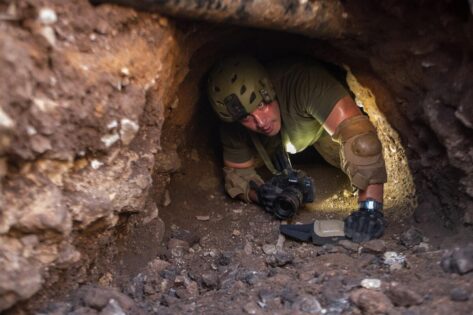by Sara Garcia, Insight Crime
Juan Manuel Delgado Cárdenas was months away from completing his studies in pharmaceutical chemistry and biology at the Autonomous University of Baja California when, on April 30, 2021, three men entered his family home in Tijuana and opened fire. Delgado Cárdenas was killed while two of his friends and two of his siblings, including his 12-year-old brother, were injured.
The student and keen boxing coach had no apparent connections to organized crime. However, several of his friends spoke to a local media outlet, Zeta, and stated that Delgado Cárdenas had been targeted for his refusal to work for criminal groups in the area.
READ MORE from Soldier of Fortune about the flow of drugs into the United States from Mexico
Prosecutors in Baja California followed this line of inquiry, investigating whether Delgado Cárdenas had been approached because of his chemical expertise and asked to help make synthetic drugs, according to Mexican newspaper, El Heraldo.
No more information has become public, but the case seemed to point toward a growing issue in Mexico: the demand for chemists to help manufacture fentanyl and methamphetamine could have deadly consequences.
The issue has caught the Mexican government’s attention at the highest levels. For instance, Mexican Defense Ministry (Secretaría de la Defensa Nacional – SEDENA) documents leaked in 2022, spoke of how the Sinaloa Cartel was seeking to recruit chemists.
It is also a problem on university campuses. During a year-long investigation into precursor chemicals, numerous chemistry professors told InSight Crime they were concerned that they, and their students, might soon be targets of aggressive recruiting.
Their role has become crucial. These chemists guide the overall production process, helping to provide training and recipes to less experienced “cooks” who operate facilities across the country. The consequences of these often rudimentary processes can also be deadly.
Knowledge is power, so it is perhaps little surprise that chemists have become targets in the last few years. One in Baja California spoke of having been contacted as far back as the 1990s by men seeking help in producing methamphetamine. Others said they were reluctant to tell people they were chemists to avoid drawing the wrong kind of attention.
“We feel less safe,” one of them told InSight Crime. “Any person could be recruited, and refusing could lead to being killed.”
The need is obvious. Cooks follow recipes, but chemists understand them and can experiment with numerous chemicals to produce the final product in various ways. Such is the case with methamphetamine production in Mexico. There are over 100 methods of producing methamphetamine, officials from Mexico City’s Attorney General’s Office told InSight Crime.
READ MORE from Soldier of Fortune about U.S. charges against “El Chapitos” for dug trafficking
And after years of experimentation, criminal networks in Mexico produce some of the purest and most potent methamphetamine in the world using chemicals that are easily and legally sourced.
And after years of experimentation, criminal networks in Mexico produce some of the purest and most potent methamphetamine in the world using chemicals that are easily and legally sourced.
That is the goal with fentanyl. But there is still a long way to go. Fentanyl is difficult and dangerous to make from scratch. So while the clandestine experimentation continues, chemists train cooks to do just the final steps of the process using well-developed precursors and their antecedents, known as pre-precursors. These cooks can be taught to follow simple recipes without requiring them to have advanced chemistry knowledge, multiple chemistry specialists confirmed to InSight Crime.
There may be more recruits on the way. According to one chemistry professor in Sinaloa, some students have signed up for chemistry courses with the sole intention of learning how to produce synthetic drugs or at least manage the basics. He has seen such a rise in interest in specific production techniques that he has stopped teaching them and instead focuses on trying to keep students safe.
“They’re going to do it anyway, even if I tell them not to. But if they are going to make drugs, they should at least not die in the process,” he told InSight Crime.
Over the years, synthetic drug producers have scaled back their need for specialized personnel. Mexican government officials estimated that no more than a dozen such experts across the country were collaborating with organized crime. Cooks, however, have proliferated.
But cutting corners is having devastating consequences. The synthesizing processes remain mostly rudimentary, carried out in clandestine laboratories away from population centers and with little infrastructure, with dangerous consequences for cooks and end users.
To begin with, cooks often handle dangerous substances without the appropriate safety equipment, which has led to explosions or cases of poisoning. One Baja California security official told InSight Crime that victims of lab explosions had been found with prior burn marks on their hands.

Searching a smugglers’ tunnel.
The danger is greater, however, for end users. Cooks in these labs mix fentanyl into counterfeit pills of drugs such as Oxycodone, Percocet, and Vicodin, with little control of the actual dose of fentanyl contained in the capsules. The same is happening with legacy drugs, such as cocaine, which traffickers are also lacing with fentanyl.
“The worst health problem of [illicit] manufacturing is not having a homogeneous [product],” Steven Campman, the chief medical examiner for San Diego County, told InSight Crime. “Some [fentanyl] pills have enough to kill a couple of people, and others are much weaker.”
The results are devastating, particularly in the United States, where tens of thousands of users overdose annually on legacy drugs and counterfeit pills laced with fentanyl.
Chemistry experts consulted by InSight Crime in Mexico City also said that illegal drug producers rarely conduct an effective cleaning process of precursors, additives, and catalysts that remain in these drugs. These could be contributing to reported side effects such as visual and auditory hallucinations among methamphetamine users and skin rashes among fentanyl users.
“The misuse of precursors, such as not cleaning them properly, is causing unpredictable harm to consumers,” Dr. Silvia Cruz, a pharmacology researcher at Mexico’s National Polytechnic Institute (Instituto Politécnico Nacional – IPN), told InSight Crime.
*Steven Dudley, Victoria Dittmar, Parker Asmann, Marcos Vizcarra, and Ben Westhoff contributed to reporting for this article.
 Soldier of Fortune Magazine The Journal of Professional Adventurers
Soldier of Fortune Magazine The Journal of Professional Adventurers






